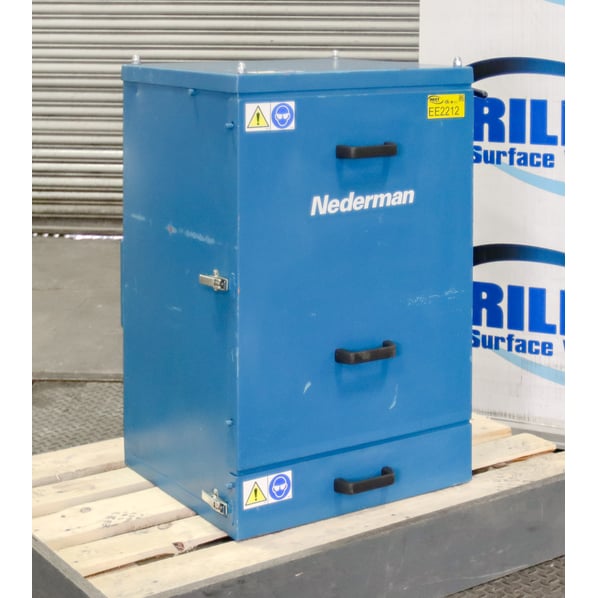Nederman Sherpa M Dust Extractor

- Stock No
- EE2212
- Manufacturer
- Nederman
- Model
- Sherpa M
- Year of Manufacture
- 2002
- Serial
- 6486280
- Condition
- Good Condition, Current Model, Seen powered at RSW
- Approx Duty CFM / M³/Hr
- 300cfm // 500M3/Hr
- Filter Area ft² / m²
- 15ft // 1.5m2
- Other Info
- Compact & Portable Unit
- Location
- Our Central Warehouse, Aldridge, UK
- Weight (kgs)
- 70Kg
- External Dimensions (WxDxH mm) [?]
- 650 x 800 x 900mm
- Delivery Your delivery options
Description
This pre-owned Nederman Sherpa M collects dust at the source, drawing it through ducting and depositing it in the filter system, discharging the cleaned extracted air into the atmosphere.
The sherpa M filter is cleaned using the manual shaker mechanism at the end of each working period, with an easy removal method of emptying the quick-release in-built metal drawer.
As well as the versatility of their size, the extractor has numerous filter material options, enabling an optional selection to cater for all kinds of different dry dusts and fumes..
Specification
- 0.75kW 1hp extractor fan
- Manual shaker
- Inbuilt bottom collection draw
- Approx duty - 300cfm 510m³/Hr
- Overall dimensions - 650mm x 800mm x 900mm
Importance of Dust Extractors
Dust in the workplace can affect product quality and employee´s health. Having a dust-free environment is essential to the health and safety of the workforce. Not only does it affect the health of employees but the dust covers the equipment affecting production processes and quality of the products.
Capturing the dust at the source prevents it from spreading, done by using a dust extractor system to facilitate the important housekeeping to avoid it from accumulating.
Factors to Consider for Your Next Dust Extractor
When implementing the safety measures to ensure minimal risk to your workers, the factors to consider when purchasing your extraction unit/system are:
- Dust Source - Does the process that produces dust occur in an enclosed or open area?
- Capacity - Does the extractor have a large enough filter area required to handle the volume of dust?
- Type of Dust – Do you need an extractor capable of handling dust at risk of self-igniting?
- Maintenance – Would a self-cleaning extractor with an automatic shaker cycle be more suitable for you?
For further guidance, find out how to carry out your own COSHH (Control of Substances Hazardous to Health) risk assessment at the HSE website to help calculate your requirements.
How do Dust Extractors Work?
Dust collection systems work in a variety of different ways but all have general principles in common. They draw process dust and particulates from the air through a filter that first captures and separates the matter, and then discharges decontaminated air back into the workplace or environment.
Dust extractors are used in many different and varied industries and so different demands are made of them; however all have common components such as a blower (or fan), dust filter, filter cleaning system, dust container and dust removal system.
Five common types of dust collection equipment are fabric filter baghouses, inertial separators (like mechanical cyclones), cartridge collectors, wet scrubbers, and electrostatic precipitators.
![]() Print / Download Nederman Sherpa M Dust Extractor Datasheet
Print / Download Nederman Sherpa M Dust Extractor Datasheet
Photographs taken prior refurbishment. Our refurbishment service is not available on all machines.
Machines & equipment for sale
- Surface Treatment
- Cleaning & Degreasing
- Polishing & Belt Linishing
- Mass Finishing
- Ovens & Furnaces
- Process Cooling
- Shot Blasting
- Dust & Fume Extraction
- Air Compressors
- Rectifiers & Transformers
- Miscellaneous
- Latest Stock
- Special Offers
- Direct From Site Clearances
- Auctions
- Brand New Machines
- Available Immediately
- Sell Your Machine
Machine Alert
Get the latest machines emailed directly to you as they become available to buy online. Sign Up Now










